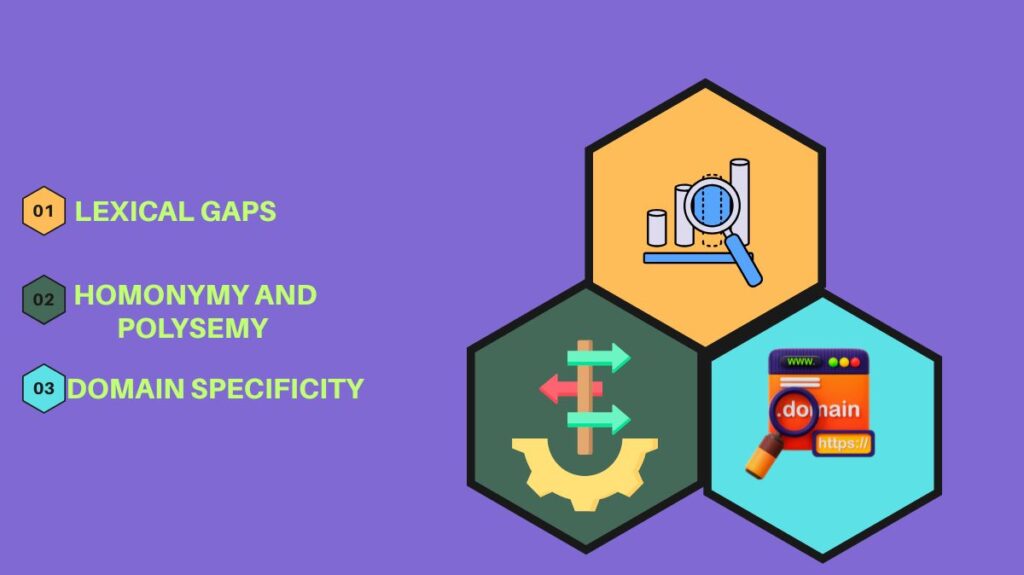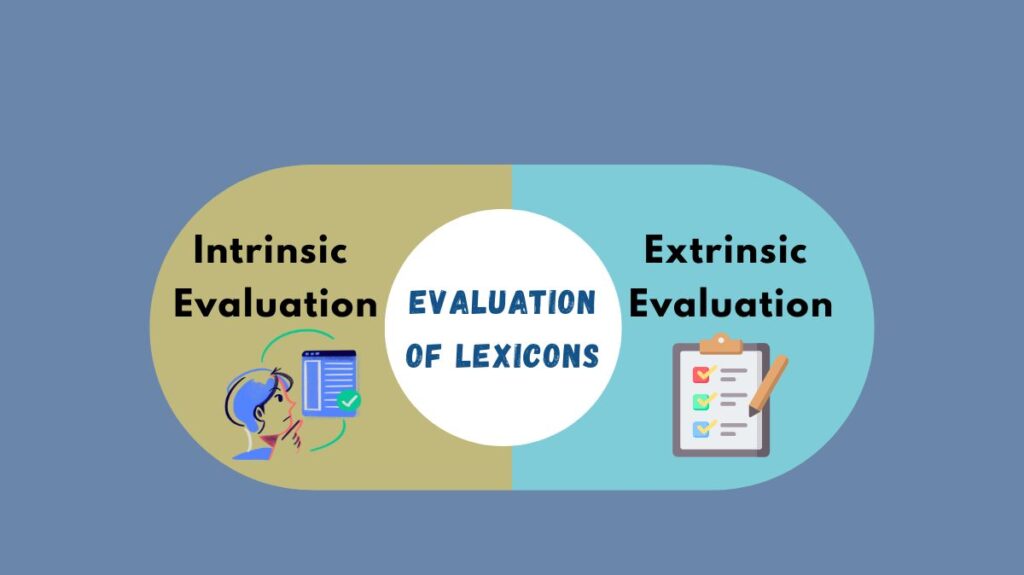The following details are covered in this blog post: Lexicon Method, Lexicons In NLP Challenges, Lexicon Evaluation, and Future Prospects for Lexicon-Based NLP Studies.
Lexicons In NLP Challenges

Lexical gaps
Lexical gaps, which arise when a word or phrase is absent from the lexicon, must be mentioned when discussing the primary difficulties in lexical-based natural language processing. As researchers have created techniques like bootstrapping and active learning to automatically increase the vocabulary, more words gradually emerge to reach this limit.
Homonymy and polysemy
Examining the polysemy and symmetry of words what occurs when a single word has numerous meanings or when several words have the same spelling or pronunciation but distinct meanings is another problem for lexical-based natural language processing. In NLP systems that are continuously improving, this might result in ambiguity and real mistakes, particularly when it comes to tasks like labelling a speech segment and elucidating a word’s meaning. NLP researchers have created context-sensitive demystification techniques, such word embedding and deep learning models, to tackle this problem.
Domain specificity
Because they rely on how well NLP systems apply to the particular tasks or contexts in which they are used, dictionaries can now cover particular fields or languages. For instance, a lexicon created for English might not be helpful in parsing the text has in other languages. Additionally, there might be technologies, medical documents, or general goals that are useful for analysing the text of a particular field, like legal or medical documents, for the aim of looking into this aspect of the task. That portion, as well as how to use these languages, has been developed by developers and researchers.
Lexicon Method
Natural language processing (NLP) offers a variety of lexicon-building techniques, each with unique advantages and disadvantages. While some approaches use automatic extraction techniques, others rely on manual annotation. Hybrid strategies that blend automated and manual techniques are also frequently employed.
- Manual Annotation: In manual annotation, linguistic information is added to a corpus of text by human specialists or crowdsourcing workers. Sentiment labels, named entities, word senses, and part-of-speech tags are examples of this data. Although manual annotation can be costly and time-consuming, it is frequently required to produce high-quality lexicons for low-resource languages or specialised fields.
- Automatic Extraction: To extract linguistic information from vast volumes of unannotated text, automatic extraction approaches employ statistical and machine learning methodologies. Collocation extraction, for instance, can be used to find phrases that frequently occur together, which can be a helpful method for finding synonyms and related terms. Words with comparable meanings can be grouped together using word sense induction, even if their surface forms differ. Although automatic extraction techniques can be scalable and quick, they can also be error-prone and necessitate extensive manual validation.
- Hybrid Methods: To capitalize on the advantages of both manual and automated techniques, hybrid approaches integrate them. For instance, automatic extraction techniques might be used to generate a vocabulary, which human specialists would then manually verify and correct. In addition to saving time and money on manual annotation, this can assist guarantee the lexicon’s completeness and accuracy.
The use of neural language models, including BERT and GPT, for lexicon construction has gained popularity in recent years. These models can learn to encode word and phrase meanings in a dense vector space after being trained on vast volumes of text. These vectors can be clustered to find word groups with related meanings, which can then be used to build a word embedding lexicon. Although they need a lot of training data and a lot of processing power, neural language models can be quite useful for expanding lexicons.
Evaluation of Lexicons

In natural language processing (NLP) research, assessing lexicon quality is a crucial step since it offers a means of gauging the precision and potency of these resources. Lexicon evaluation techniques fall into two primary categories: extrinsic and intrinsic.
- Intrinsic Evaluation: Regardless of the specific NLP task or application, intrinsic evaluation techniques concentrate on assessing the lexicon’s quality. This may entail assessing the lexicon’s ability to capture semantic links between words as well as the coverage and accuracy of its entries. Metrics like precision, recall, F1 score, and word similarity scores can be used for intrinsic evaluation.
- Extrinsic Evaluation: Extrinsic evaluation techniques concentrate on assessing how well an NLP system performs in a particular job or application while using the lexicon as a resource. This may entail evaluating the NLP system’s efficacy or accuracy using a benchmark dataset both with and without the lexicon. Metrics including accuracy, precision, recall, F1 score, and task-specific metrics can be used for extrinsic evaluation.
Along with these assessment techniques, the quality and representativeness of the data utilized for evaluation should also be taken into account. To verify the accuracy and coverage of the lexicon, evaluation datasets should contain a variety of instances and be representative of the target domain.
Lexical evaluation in NLP presents a number of difficulties. Given that different lexicons may differ in their scopes, granularities, and annotation levels, one difficulty is the absence of a gold standard for comparison. Determining a single assessment criteria that encompasses the lexicon’s quality and utility across all jobs and applications presents another difficulty. Researchers frequently assess the performance of various lexicons on a variety of benchmark datasets and employ many evaluation criteria in order to overcome these issues.
Future prospects for lexicon-based NLP studies
- Multilingual Lexicons: When it comes to the development of multilingual dictionaries, multilingual lexicons are one of the most important scientific advancements in the near future. This is because they can be utilised in a large number of languages, which gives the most important languages and the fewest resources which also lack a large portion of private dictionaries great importance.
- Domain-Specific Lexicons: In the other area of research and development, there are dictionaries that contain material that can be applied to specialised fields. For example, dictionaries that include terms related to biomedicine, engineering, statistics, and other fields.
- Incremental Lexicon Learning: This type of progressive lexicon was created to accommodate the development and so forth of new things. It can change over time as it attempts to create algorithms that can learn and develop on their own and incorporate new words and senses into the lexicon.
Conclusion
To sum up, lexicons are one of the most important components of scientific research in Natural Language Processing (NLP). They offer a high-quality resource that expands a variety of applications, including sentiment analysis, which was discussed earlier, as well as machine translation and named entity recognition. However, a thorough examination of the various approaches and difficulties that that field faces such as coverage, accuracy, scalability, and the whole scopeis a necessary component of creating high-quality dictionaries.
Since every evaluation method has its own limits, as do the data employed in it, a comprehensive and effective study is being established in that section. The development of these dictionaries in different languages is just one of the many fascinating avenues for lexicon-based NLP research that lie ahead. In that section, there are numerous methods for collecting data, such as manual annotations and automatic extraction from collections. Each method has its own placement, limitations, and preferences.
The creation of multilingual and domain-specific lexicons, augmented lexicon learning, lexical integration, and lexical interpretation are some of the intriguing avenues for lexicographical-based NLP research in the future. Lexicons will undoubtedly continue to be a vital tool for expanding our comprehension of natural language as long as innovation in this area persists.
Read more on Types Of Lexicon: A Complete Guide To Word Resources
